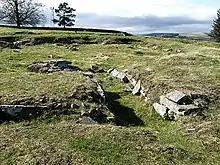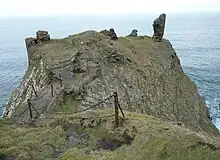Scheduled monuments in the Scottish Borders
A scheduled monument in Scotland is a nationally important archaeological site or monument which is given legal protection by being placed on a list (or "schedule") maintained by Historic Environment Scotland. The aim of scheduling is to preserve the country's most significant sites and monuments as far as possible in the form in which they have been inherited.[1]

The process of scheduling is governed by the Ancient Monuments and Archaeological Areas Act 1979, which aims "to make provision for the investigation, preservation and recording of matters of archaeological or historical interest". The term "scheduled monument" can apply to the whole range of archaeological sites which have been deliberately constructed by human activity but are not always visible above ground. They range from prehistoric standing stones and burial sites, through Roman remains and medieval structures such as castles and monasteries, to later structures such as industrial sites and buildings constructed for the World Wars. Some buildings or structures which were both scheduled and listed have had their listing designations removed to reduce the duplication.
In 2017 there were 8,238 scheduled monuments in Scotland.
Notable Scheduled Monuments in the Scottish Borders
| Name | Location | Description | Ref No | Image |
|---|---|---|---|---|
| White Meldon | Peebles | Prehistoric hill fort | SM114 |  |
| Old Bonkyl Kirk | Bunkle and Preston | Remains, especially the apse, of late medieval parish church | SM381 |  |
| St Helen's Kirk, Cockburnspath | Cockburnspath | Ruined Norman church | SM382 |  |
| Coldingham Priory cloisters | Coldingham | Remains of medieval cloisters | SM383 |  |
| Hume Castle | Hume | Late 12th- or early 13th-century castle of enceinte | SM387 |  |
| Drochil Castle | Newlands | Large unfinished ruined castle | SM1495 |  |
| Northshield Rings | Eddleston | Prehistoric hill fort | SM731 | .jpg.webp) |
| Yarrow Stone | Yarrow | Inscribed stone | SM1727 |  |
| Kirkhope Tower | Kirkhope | Tower and barmkin | SM1728 |  |
| Newark Castle | Selkirk | Large, ruined tower house in grounds of Bowhill House | SM1729 |  |
| Bonkyll Castle | Bunkle and Preston | Traces of medieval fortress | SM2407 |  |
| Milkieston Rings | Eddleston | Prehistoric hill fort | SM2416 | .jpg.webp) |
| Torwoodlee broch | Caddonfoot | Prehistoric broch | SM2448 |  |
| Black Meldon | Peebles | Prehistoric hill fort | SM2703 | .jpg.webp) |
| Stow Old Bridge | Stow | Old bridge | SM2855 |  |
| Fatlips Castle | Minto | Renovated Pele tower | SM2881 |  |
| Dreva Craig | Stobo | Prehistoric hill fort | SM2895 |  |
| Soutra Aisle | Fala | Remains of a medieval hospital including a rebuilt portion of the associated church | SM3067 |  |
| Old Thirlestane Castle | Lauder | Remains of 13th- to 15th-century castle | SM4035 |  |
| Blanerne Castle | Bunkle and Preston | Remains of a 16th-century fortified residence | SM4216 |  |
| Fast Castle | Coldingham | Ruined remains of coastal fortress | SM4328 |  |
| Dryhope Tower | Yarrow | Remains of a medieval tower house | SM6161 |  |
| Horsburgh Castle | Innerleithen | Remains of late medieval tower-house | SM6284 |  |
| Torwoodlee Tower | Caddonfoot | Remains of 17th-century tower-house | SM8687 |  |
| Jedburgh Abbey | Jedburgh | Augustinian Abbey founded as a priory around 1138 | SM13126 | .jpg.webp) |
| Greenknowe Tower | Gordon | Remains of L-plan tower-house | SM13590 |  |
| Dryburgh Abbey | Dryburgh | Ruined 12th-century abbey | SM90103 |  |
| Edin's Hall Broch | Duns | Prehistoric fort, broch and settlement | SM90134 |  |
| Foulden Old Tithe Barn | Foulden | 18th-century tithe barn | SM90148 |  |
| Hermitage Castle | Castleton | Semi-ruined castle | SM90161 |  |
| Edrom Church Norman doorway | Edrom | Norman doorway to burial vault | SM90135 |  |
| Kelso Abbey | Kelso | 12th-century Tironesian abbey | SM90177 |  |
| Melrose Abbey | Melrose | Ruined 14th- and 15th-century abbey | SM90214 |  |
References
- "What is scheduling?". Historic Environment Scotland. Retrieved 2 September 2017.